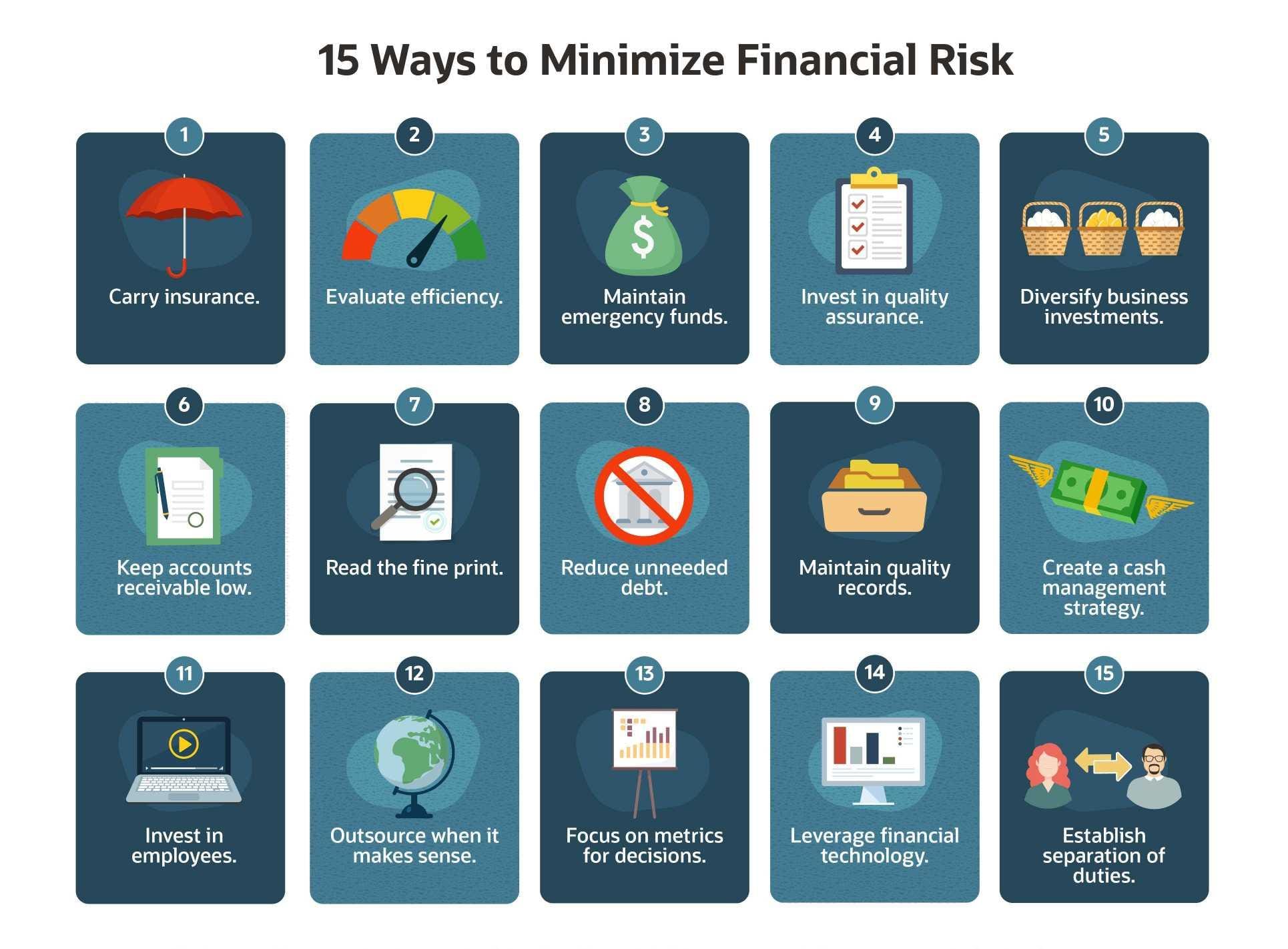Financial risk is often unavoidable in business. Sometimes, it’s even acknowledged as a necessary condition to achieve a desired return. This paradox highlights the diversity of financial risks and their sources and underscores the need for business leaders to understand the financial risks inherent in their companies, no matter the size. Even companies with the most thoughtful, strategic business leaders encounter influences beyond their control — think macroeconomic shifts and political unrest — making identifying and preparing for the more foreseeable risks even more critical. This article identifies 10 common types of business risk and 15 ways to minimize them.
What Is Financial Risk for Companies?
Financial risk is a broad term for situations that can lead to an adverse commercial impact, such as reduced profitability, loss of capital, strained cash flow and possibly business closure. Risk and reward tend to have a direct correlation — the greater the potential risk, the bigger the potential payoff. However, unlike high-stakes gamblers, business leaders have a fiduciary responsibility to protect their company and its constituents against overexposure to financial risk.
That list of undesirable outcomes can be especially concerning when one considers the significant number and variety of financial risks, including credit risk, market risk and fraud, to name a few. This is where risk management comes into the picture. Risk management is the preventative approach to mitigating financial risks. It’s a combination of identifying, monitoring, controlling (where possible) and planning for potential risks to curtail their impact. Vigilance and preparation are key. Vigilance includes establishing and monitoring various internal and external indicators that can raise or lower risk. Preparation refers to developing strategies to avoid or lessen risks that carry the potential for losses, including, but not limited to, carrying various types of insurance policies.
Key Takeaways
- Financial risk is unavoidable but can be mitigated with careful planning and the right tools.
- Different types of financial risk come from external sources, endemic factors and internal processes.
- High-quality, accurate data is fundamental to risk management.
- Explore 15 ways to avoid, reduce, transfer or accept financial risk.
Types of Financial Risks
The first step in creating an effective financial risk mitigation plan is to identify the types of risks that could impact a business. Some types of risks are more pertinent than others, depending on the industry, the size of the company and other operational factors. Understanding the specific nuances of how these risks could impact a business allows for better planning and more effective mitigation. Ten common types of financial risk are:
-
Credit risk
-
Market risk
-
Competitive risk
-
Liquidity risk
-
Cash flow risk
-
Growth risk
-
Leverage risk
-
Global risk
-
Errors
-
Fraud
Extending credit to customers is a standard practice in many industries, and it can be a useful way to expand a business’s customer base and increase revenue. But extending credit also introduces a higher potential for uncollected sales. When customers don’t pay, the seller’s business loses revenue and has unrecouped costs for products or services delivered. And if a business has only a small number of customers, extending credit exposes it to even more credit risk if one of those customers experiences cash flow problems or goes out of business.
Market risk for business refers to the external forces endemic to a company’s specific industry. Evolving customer preferences, advancements in technology and other disruptors can cause an industry to morph and change, requiring businesses to adapt to survive. Consider the evolution in the recorded music industry from vinyl albums, to cassettes, to CDs, to digital streaming. Market risks are often out of management’s control.
The performance of other companies in a business’s market creates competitive risk. Moves by existing competitors that provide comparable goods or services can upset a business’s sales and cash inflows, for example, by changing prices, product features or distribution strategies. In addition, new competitors can emerge to vie for the same customers’ attention and budgets by fulfilling their needs in different ways. A good example is how entertainment streaming services introduced competitive risk to movie theaters.
A company’s liquidity refers to its ability to pay its current obligations using short-term assets, such as cash, accounts receivable and short-term investments. Liquidity can be thought of as a more specific and immediate form of cash flow. Liquidity risk is usually a matter of timing — ensuring that cash flow or the ability to convert assets to cash quickly is adequate to make timely payments on debt. Liquidity risk is higher when timing is out of sync or capital is locked up in long-term assets. An equipment-heavy construction business that must pay for building supplies in advance of cash collections would have higher liquidity risk than a cash-and-carry retail grocery store, for example.
Cash flow risk refers to the potential imbalance between all cash inflows and outflows. It involves the ability (or inability) to pay immediate and medium- and long-term obligations on a constant basis and is often impacted by systemic cash management policies. For example, periods of negative cash flow — when outflows are greater than inflows — can be overcome, but consistent negative cash flow is usually unsustainable. Consider the cash flow risk for a business that extends 120 days of credit to its customers but is subject to 60-day payment terms from its suppliers.
Business growth is typically viewed as a positive trend, but companies should be aware of potential risks. For one, overextension of capital to invest in expansion can cause liquidity issues. Second, stress on operational infrastructure can cause breakdowns in equipment, distribution interruptions or employee burnout, all of which can have fiscal consequences. Third, a business’s reputation or its product’s brand image can be impaired by poorly planned or executed growth, causing long-term financial problems. And last, even the best forecasts and projections for new business development contain estimates with varying degrees of accuracy.
Leverage refers to the amount of borrowed capital a business uses to finance its operations or new investments. Leverage risk refers to the potential for the cost of these borrowings to become prohibitive or greater than the return on the underlying investment. Rising interest rates and lower-than-expected returns are variables that increase leverage risk. Another sort of leverage risk exists when a business maxes out its available credit and is unable to access additional funds in the event of emergencies or revenue downturns.
In the interconnected global economy, businesses of all sizes encounter a level of global risk; it’s not just reserved for large international conglomerates. Global risk stems from changes in government policy, exchange rates, foreign country economies, social unrest, cybersecurity threats, public health and many other factors. Bringing these issues closer to home, consider the global risk inherent in direct supply sourcing, such as shortages or price changes on parts imported from another country. Indirect supply chain issues are another example, such as the inability to purchase delivery trucks due to international chip shortages. Both examples ultimately have an impact on a business’s sales and profitability.
Business leaders rely on accurate information to make well-informed decisions. In addition to running their everyday business, they need good data to identify and monitor business risks. Errors in any of this information increase the likelihood of sub-par decision-making and financial loss.
Fraud is a real risk to most businesses. The potential for theft, embezzlement or cybersecurity breaches can come from both internal and external sources. Fraud causes direct financial loss, such as revenue skimming and asset loss, and can raise other risks, including reputation, compliance and legal risks with indirect financial consequences.

15 Ways to Mitigate Financial Risk
By identifying and monitoring risks, a company is better positioned to mitigate their financial impact. The four approaches to mitigating financial risk are avoidance, reduction, transference and acceptance. Avoidance involves changing course to dodge the factors that cause the financial risk. Reduction takes the approach of managing through the risk but with measures to minimize its effects. Transference means off-loading or sharing some of the risk with other parties, such as business partners or insurance agencies. Finally, acceptance is the decision to move forward, accepting the potential consequences of the risk rather than taking action to mitigate or avoid it. Businesses may choose a particular approach based on the type of financial risk involved or they may opt to combine multiple approaches to address a risk. The 15 ways to mitigate financial risk listed here draw on all four approaches.
-
Carry insurance
-
Evaluate efficiency
-
Maintain emergency funds
-
Invest in quality assurance (QA)
-
Diversify business investments
-
Keep accounts receivable (AR) low
-
Read the fine print
-
Reduce unneeded debt
-
Maintain quality records
-
Create a cash management strategy
-
Invest in employees
-
Outsource when it makes sense
-
Focus on metrics for decisions
-
Leverage financial technology
-
Establish separation of duties
Insurance is a way to transfer some financial risk to a third party. It comes in handy when paying for an unexpected loss, thereby preserving company capital. However, keep in mind that insurance policies carry premium costs, and while the proceeds of a claim can help finance recovery, they don’t eliminate the risk or the disruption. There are dozens of business insurance policies covering all kinds of financial risks, including product liability, crime, commercial property claims, workers compensation, business interruption and cybercrime.
By maximizing operational efficiency a business can unlock cash flow that can be redirected to cover the impact of financial risk. Additionally, the process of continually evaluating aspects of a business can help identify potential business risks.
Establishing cash reserves is a way to prepare for the impact of financial risks. Along with insurance, emergency funds can help lessen financial losses and keep a business running. Emergency funds can be internally generated through positive cash flow or they can be in the form of an accessible line of credit. Preplanning is necessary in both cases.
Instituting strong QA measures to make sure that products and services meet desired quality standards is a way to reduce product-related financial risks. Checklists, checkpoints, sampling and supervision throughout the production process can help ensure better outcomes.
Diversification is a way to spread risk across multiple areas. When businesses hold investments in other companies through stocks or ownership stakes, selecting a variety of industries helps minimize the risk that investments all rise and fall together. Further, diversifying investments between equity and debt can help minimize volatility and risk. Similarly, diversifying a business’s income streams, so as not to rely on a small number of products or customers, is another way to hedge financial loss and minimize risk.
As AR balances age, collection becomes less likely. Uncollected AR results in lost revenue, reduced cash flow and lost profits, so it’s important to stay on top of the balances by using an AR aging report, which tracks the payment status of a company’s AR, or other similar tools. Additionally, AR vigilance can uncover customers that present credit risks so future sales terms can be adjusted to prevent future losses.
Misunderstandings among commercial partners can cause all sorts of problems that can result in financial loss. Documenting agreements in writing helps reduce ambiguity and the likelihood of financial loss, especially when it comes to the finer details of an arrangement.
Most businesses rely on loans from time to time to support gaps in cash flow and for long-term investments. However, it’s important to manage leverage risk by keeping loan balances as low as possible to avoid excess borrowing costs, such as interest charges and bank fees, as well as heavy cash flow drains from inflated loan payments. Additionally, lower outstanding loan balances can maximize a company’s available credit for emergencies and unforeseen challenges and opportunities.
Keeping quality records is fundamental to managing financial risk because it provides clean data for historical analysis and future visibility. It’s also a primary way to avoid compliance risk. Businesses have many reporting requirements from lenders, government agencies, industry regulators and shareholders to prove they are meeting regulations and abiding by the law. Non-compliance results in direct penalties and indirect reputational risk. Sloppy record-keeping increases the risk of bad decision-making and non-compliance, making maintaining quality records table stakes.
Running out of cash is one of the most common reasons that businesses fail. Creating a cash management strategy helps reduce financial risks through planning and prevention. Forecasting cash inflows and outflows, monitoring AR and accounts payable balances, managing debt payments, keeping an eye on currency exchange and interest rates and staying close to market demand all play a part in developing a cash management strategy and can help lower risk.
Employees can have a big impact on the success or failure of a business. This is especially evident in services industries, but it’s also a factor that affects productivity in non-services industries. Because there is a direct correlation between the adequacy of employee training and business output, investing in employees reduces the risk of costly errors that can damage a company’s reputation.
Outsourcing certain functions is one way to mitigate certain financial risks by saving time and money. Hiring third-party specialists to handle certain parts of a business can bring cost savings, thanks to the service provider’s economies of scale. Outsourcing can also save time because expertise is already in place. Financial risk is shared between the company and the service provider, and cost savings can be used to reduce risk in other areas of the business. Beware, though, that while outsourcing can reduce some financial risks, it may introduce others, so it’s important to evaluate where it makes sense.
Consider the adage, “You can’t manage what you don’t measure.” Using objective metrics helps lower financial risks by supporting impartial decision-making and helping leadership stay focused on tangible goals. Planning, measuring and using standardized, quality information can help keep a business on track and provide early warning if it’s not. Impulsive or under-informed decisions tend to increase the level of risk.
The right financial technology can bolster the other tactics for minimizing financial risk. Robust technology, such as cloud-based accounting software and integrated enterprise resource planning (ERP) systems, is essential for identifying and analyzing trends that might become risks — or opportunities. Financial technology is useful for planning and developing metrics and reduces the potential for manual errors in record-keeping.
A strong internal control environment helps reduce the risk of errors and fraud. The internal control environment is a network of processes designed to catch anomalies before they happen (prevent controls) and to detect them if they do happen (detect controls). Segregation of duties is a primary control that works by ensuring that no single person has full control of a single transaction, usually by separating functions like recording, approving, paying and reconciling. Segregation of duties can be a challenge for small organizations but can be assisted by the right technology.
Mitigate Financial Risks With NetSuite Financial Management Software
The 15 ways to minimize financial risks outlined in this article share a common need for accurate, detailed and reliable financial information. NetSuite financial management solutions can help with managing financial risks, from planning to monitoring. The solution’s financial, headcount and operational data is essential for risk management planning. Its dashboards, alerts and real-time visibility can help monitor risk metrics for early intervention. And access controls and an automated workflow provide strong internal controls for accurate data and reduced risk of fraud.
Businesses can’t eliminate all financial risks, but they can actively manage their risk/reward dynamic. Understanding, monitoring and mitigating financial risks are essential steps to maximize a business’s success. Minimizing financial risks means having plans and processes in place to reduce, share or avoid potential loss of profitability or capital, strained cash flow and business closure. The 15 approaches discussed above can help minimize financial risks, including credit, liquidity, leverage, market and growth risks, among others. Access to high-quality, current data to support planning and decision-making is foundational.
#1 Cloud
Planning Software
Financial Risk Mitigation FAQs
Why is it important to manage financial risks?
Financial risk is a broad term for situations that can lead to an adverse commercial impact, such as reduced profitability, loss of capital, strained cash flow and possibly business closure. While businesses can’t eliminate all financial risks, they can actively manage their risk/reward dynamic by understanding, monitoring and mitigating those risks.
How do you identify financial risks?
The first step in creating a financial risk mitigation plan is to identify the types of risks that could impact a business. Some types of risks are more relevant than others, depending on the industry, the size of the company and other operational factors. Reviewing a business’s financial reporting, such as balance sheet, income statement and cash flow, can highlight areas of risk. Comparing those reports over time identifies trends that may be heading in a risky direction.
What is an example of financial risk management?
There are four approaches to financial risk management: avoidance, reduction, transference and acceptance. Avoidance, for instance, involves changing course to dodge the factors that cause the financial risk. Carrying insurance is an example of financial risk management that transfers some financial risk to a third party.
What are the best ways to minimize financial risk when starting a business?
Entrepreneurs need to consider financial risks in the same ways that established businesses do. This includes being diligent with contracts, carrying insurance, investing in employees, developing metrics and outsourcing when it makes sense. It’s helpful to establish quality records by leveraging financial technology from the outset. As new businesses grow, they can work to mitigate financial risks by evaluating efficiency, investing in quality assurance, keeping accounts receivable low and using separation of duties where possible. Nonetheless, since cash flow is a primary financial risk when starting a business, it’s important to maintain emergency funds, diversify investments and keep debt balances as low as possible as part of a formal cash management strategy.
What methods do you use to minimize risk?
There are four approaches to mitigating financial risk: avoidance, reduction, transference and acceptance. Fifteen examples of ways to minimize financial risk are:
- Carry insurance.
- Evaluate efficiency.
- Maintain emergency funds.
- Invest in quality assurance (QA).
- Diversify business investments.
- Keep accounts receivable (AR) low.
- Read the fine print.
- Reduce unneeded debt.
- Maintain quality records.
- Create a cash management strategy.
- Invest in employees.
- Outsource when it makes sense.
- Focus on metrics for decisions.
- Leverage financial technology.
- Establish separation of duties.









